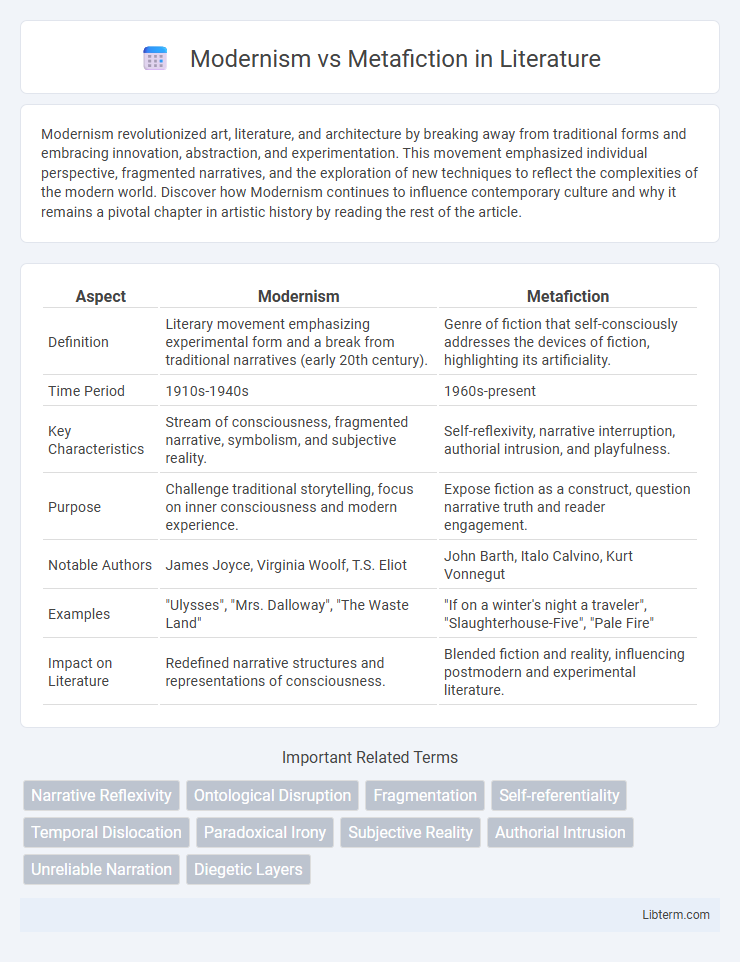Modernism revolutionized art, literature, and architecture by breaking away from traditional forms and embracing innovation, abstraction, and experimentation. This movement emphasized individual perspective, fragmented narratives, and the exploration of new techniques to reflect the complexities of the modern world. Discover how Modernism continues to influence contemporary culture and why it remains a pivotal chapter in artistic history by reading the rest of the article.
Table of Comparison
| Aspect | Modernism | Metafiction |
|---|---|---|
| Definition | Literary movement emphasizing experimental form and a break from traditional narratives (early 20th century). | Genre of fiction that self-consciously addresses the devices of fiction, highlighting its artificiality. |
| Time Period | 1910s-1940s | 1960s-present |
| Key Characteristics | Stream of consciousness, fragmented narrative, symbolism, and subjective reality. | Self-reflexivity, narrative interruption, authorial intrusion, and playfulness. |
| Purpose | Challenge traditional storytelling, focus on inner consciousness and modern experience. | Expose fiction as a construct, question narrative truth and reader engagement. |
| Notable Authors | James Joyce, Virginia Woolf, T.S. Eliot | John Barth, Italo Calvino, Kurt Vonnegut |
| Examples | "Ulysses", "Mrs. Dalloway", "The Waste Land" | "If on a winter's night a traveler", "Slaughterhouse-Five", "Pale Fire" |
| Impact on Literature | Redefined narrative structures and representations of consciousness. | Blended fiction and reality, influencing postmodern and experimental literature. |
Understanding Modernism: Key Features
Modernism emphasizes fragmented narratives, stream-of-consciousness techniques, and a focus on individual perception to challenge traditional storytelling. It often explores themes of alienation, existential uncertainty, and the breakdown of social norms through experimental forms. Central to Modernism is the quest to represent reality in a subjective, multifaceted way, contrasting with Metafiction's self-referential and self-aware narrative strategies.
Defining Metafiction: Literary Self-Awareness
Metafiction emerges as a postmodern literary technique that self-consciously addresses the nature and structure of fiction itself, often breaking the fourth wall to highlight its own artifice. Unlike Modernism, which emphasizes fragmented narratives and stream-of-consciousness to explore subjective experience, metafiction explicitly foregrounds the act of storytelling, making readers aware of the text's constructed reality. This literary self-awareness invites critical reflection on the relationship between fiction and reality, challenging traditional narrative boundaries and reader expectations.
Historical Context: Modernism’s Emergence
Modernism emerged in the early 20th century as a response to rapid industrialization, World War I, and shifting social norms, reflecting a break from traditional forms and embracing experimental techniques. This historical context influenced its fragmented narratives, stream of consciousness, and a focus on individual perception to represent a fractured reality. In contrast, metafiction arises later, often postmodern, critiquing and self-referentially engaging with Modernist innovations to question authorship and narrative authority.
Metafiction’s Rise in Postmodern Literature
Metafiction emerged prominently in postmodern literature as a self-reflexive narrative technique that challenges traditional storytelling by drawing attention to its own artificiality. Unlike modernism's focus on fragmented perspectives and stream of consciousness, metafiction deliberately blurs the boundaries between fiction and reality to question the nature of narrative truth. This rise in metafiction reflects postmodernism's skepticism toward grand narratives and its emphasis on playfulness, intertextuality, and the instability of language.
Narrative Structure: Linear vs. Self-Reflexive
Modernism typically employs a linear narrative structure characterized by a coherent and chronological progression of events, emphasizing psychological depth and fragmented perspectives to explore human consciousness. In contrast, metafiction adopts a self-reflexive narrative approach that disrupts traditional storytelling by highlighting the artificiality of the text, often breaking the fourth wall and drawing attention to its own construction. This self-awareness challenges readers' expectations and invites critical engagement with the nature of narrative and reality within the fictional work.
Themes Explored: Reality, Identity, and Artifice
Modernism and metafiction both interrogate reality, identity, and artifice, but approach these themes differently. Modernism often destabilizes objective reality through fragmented narratives and stream-of-consciousness techniques, emphasizing the subjective nature of identity and the fractured experience of the modern world. Metafiction self-consciously exposes the artificiality of storytelling, blurring the boundaries between fiction and reality to question the construction of identity and the role of the author in shaping truth.
Authorial Presence: Hidden vs. Exposed
Modernism often features a hidden authorial presence, where the narrative voice remains subtle, allowing readers to immerse themselves in fragmented perspectives and experimental forms without direct authorial intrusion. In contrast, metafiction deliberately exposes the authorial presence by drawing attention to the text's artificiality and the author's role in constructing the narrative, challenging traditional storytelling conventions. This difference highlights how modernism seeks immersive complexity while metafiction foregrounds self-awareness and narrative manipulation.
Reader Engagement: Immersion or Distancing
Modernism emphasizes reader immersion by employing stream-of-consciousness and fragmented narratives that invite deep emotional and psychological involvement. Metafiction, conversely, uses techniques like self-referentiality and narrative disruption to create reader distancing, encouraging critical awareness of the text as an artifact. This contrast highlights how Modernism seeks to engulf readers within the story world, while Metafiction promotes analytical detachment and reflection on storytelling itself.
Iconic Works: Modernist and Metafictional Texts
James Joyce's "Ulysses" exemplifies Modernism with its stream-of-consciousness technique and nonlinear narrative, pushing boundaries of literary form. In contrast, Italo Calvino's "If on a Winter's Night a Traveler" typifies metafiction through self-referential storytelling and fragmented narratives that question the nature of reading and authorship. Virginia Woolf's "Mrs. Dalloway" and John Fowles' "The French Lieutenant's Woman" further underscore the divide, with Woolf emphasizing psychological depth and Fowles employing metafictional interruptions and multiple endings.
Legacy and Influence: Shaping Contemporary Narrative
Modernism revolutionized narrative techniques through stream of consciousness and fragmented structures, influencing 20th-century literature by prioritizing subjective experience and introspection. Metafiction emerged as a postmodern evolution, self-consciously blurring fiction and reality to challenge traditional storytelling conventions and reader expectations. Both movements significantly shaped contemporary narrative by encouraging experimental forms and deepening exploration of truth, identity, and the nature of storytelling itself.
Modernism Infographic

 libterm.com
libterm.com